ACCG2024 Financial Accounting: Impairment Testing Report Analysis
VerifiedAdded on 2022/09/06
|12
|1834
|22
Report
AI Summary
This report examines the crucial aspects of impairment testing for non-financial assets, with a focus on the Australian Accounting Standards Board (AASB) 136 guidelines. The analysis centers on Flight Centre Travel Group (FLT), an ASX-listed company, evaluating its adherence to AASB 136 in disclosing impairment losses related to goodwill and intangible assets. The report details the disclosure requirements under AASB 136, including the valuation techniques and fair value hierarchy used. It assesses FLT's compliance with these requirements, highlighting the company's handling of goodwill and intangible assets in its financial statements. Furthermore, the report identifies critical issues in impairment testing, such as the identification of cash-generating units, the selection of assumptions, and the importance of transparent disclosures. The report concludes by emphasizing key considerations for directors when reviewing impairment calculations, such as proper reconciliation, transparency, accurate identification of cash-generating units, and the careful selection of assumptions. The report uses the annual report of FLT and various sources to analyze the practical implications of impairment testing.
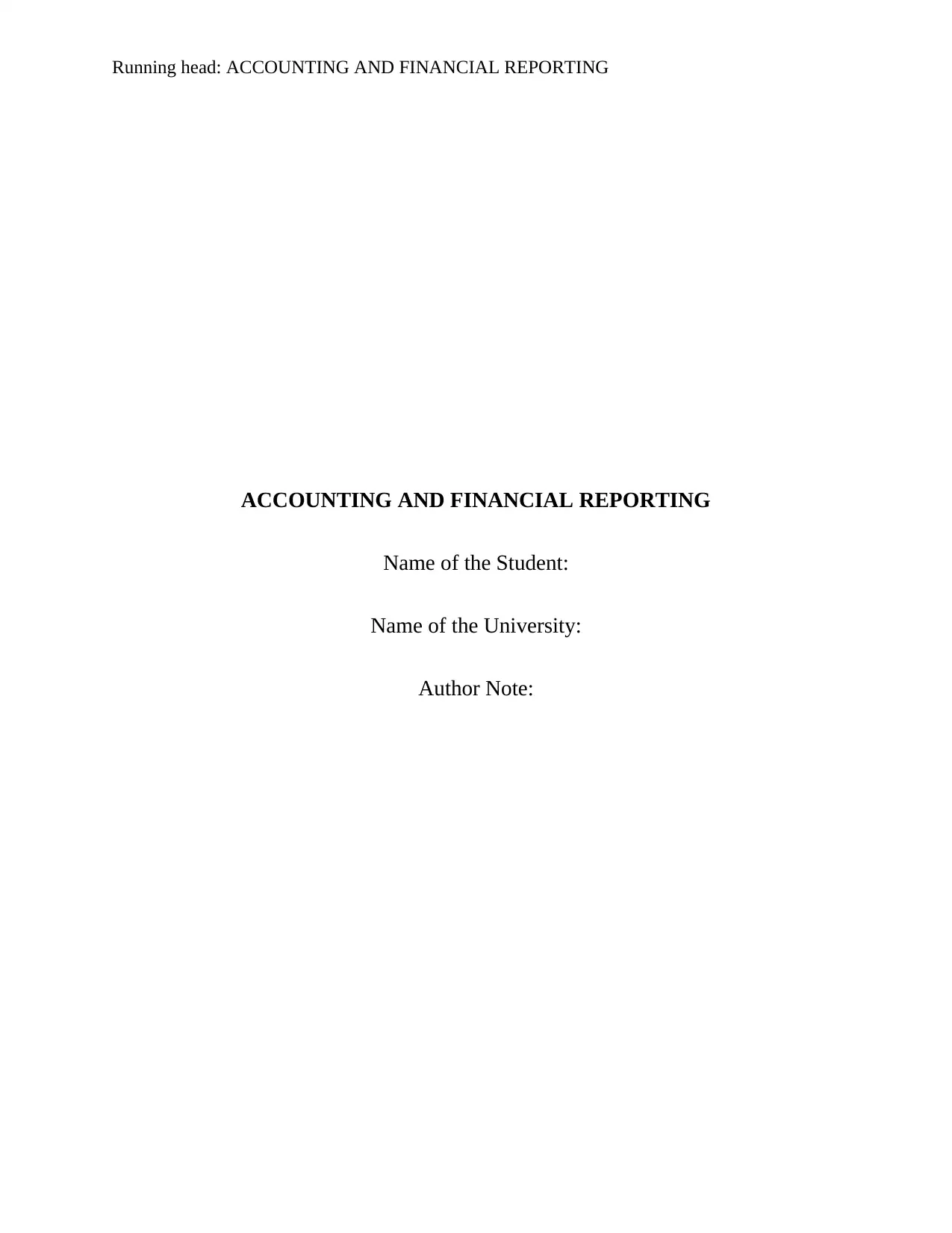
Running head: ACCOUNTING AND FINANCIAL REPORTING
ACCOUNTING AND FINANCIAL REPORTING
Name of the Student:
Name of the University:
Author Note:
ACCOUNTING AND FINANCIAL REPORTING
Name of the Student:
Name of the University:
Author Note:
Paraphrase This Document
Need a fresh take? Get an instant paraphrase of this document with our AI Paraphraser
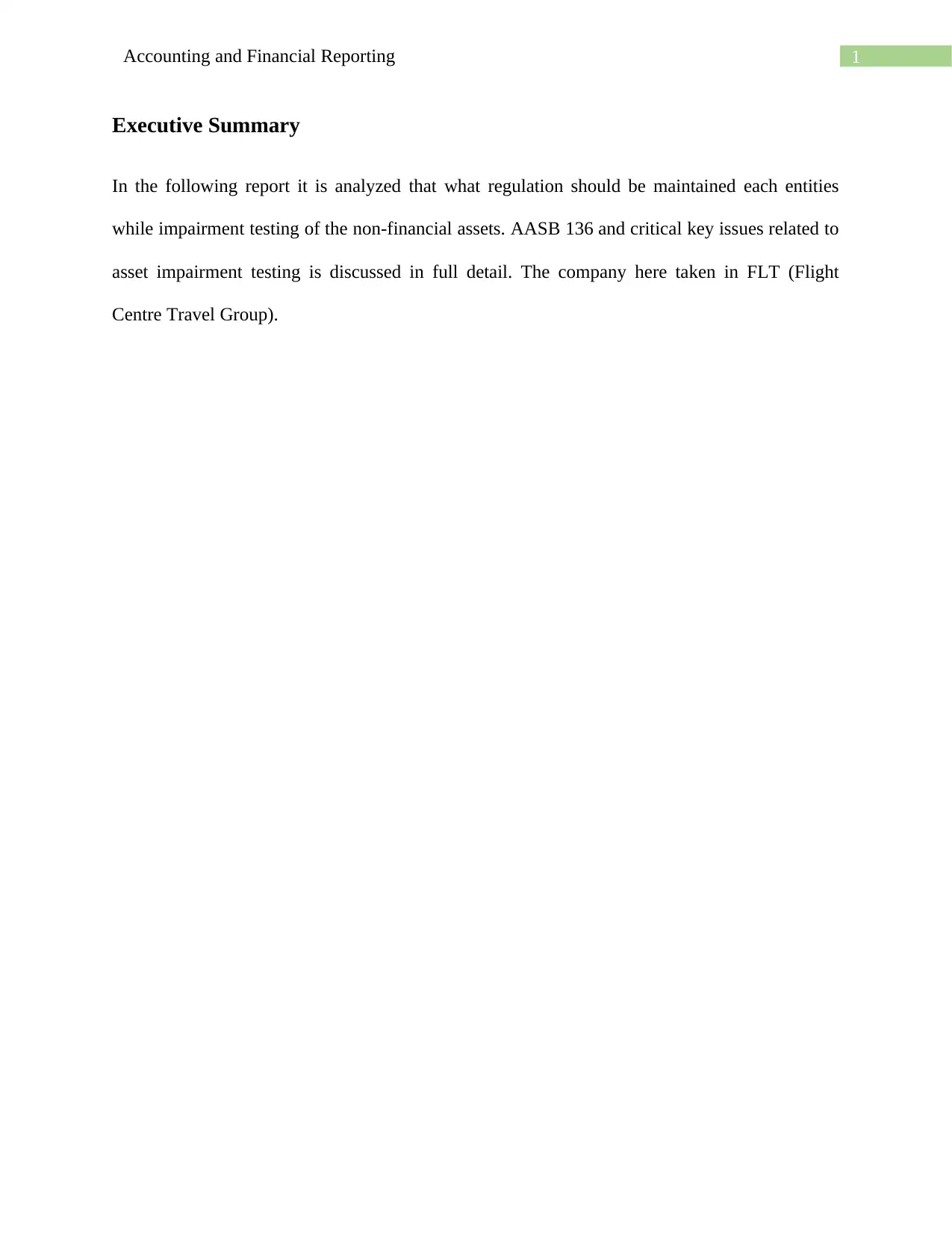
1Accounting and Financial Reporting
Executive Summary
In the following report it is analyzed that what regulation should be maintained each entities
while impairment testing of the non-financial assets. AASB 136 and critical key issues related to
asset impairment testing is discussed in full detail. The company here taken in FLT (Flight
Centre Travel Group).
Executive Summary
In the following report it is analyzed that what regulation should be maintained each entities
while impairment testing of the non-financial assets. AASB 136 and critical key issues related to
asset impairment testing is discussed in full detail. The company here taken in FLT (Flight
Centre Travel Group).
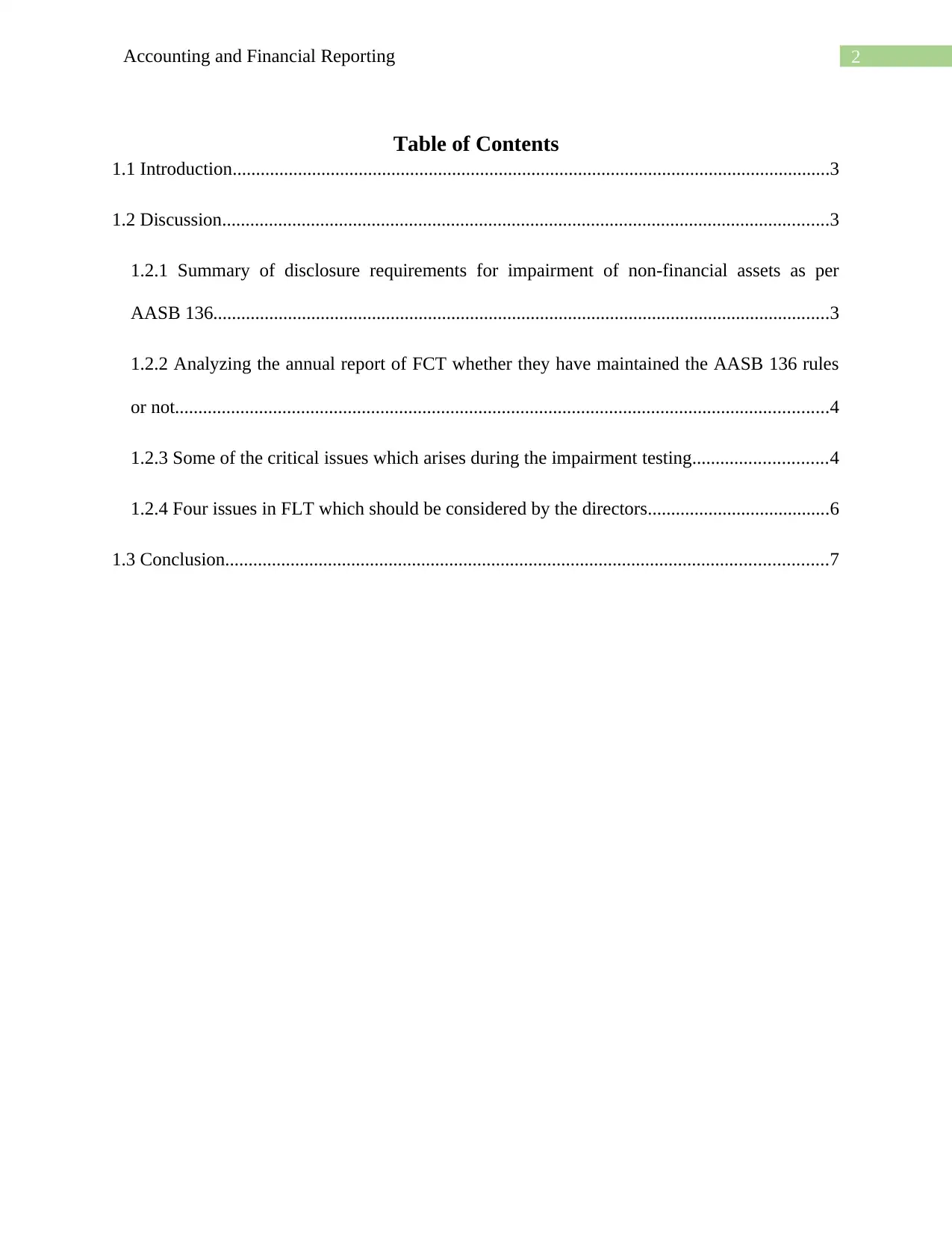
2Accounting and Financial Reporting
Table of Contents
1.1 Introduction................................................................................................................................3
1.2 Discussion..................................................................................................................................3
1.2.1 Summary of disclosure requirements for impairment of non-financial assets as per
AASB 136....................................................................................................................................3
1.2.2 Analyzing the annual report of FCT whether they have maintained the AASB 136 rules
or not............................................................................................................................................4
1.2.3 Some of the critical issues which arises during the impairment testing.............................4
1.2.4 Four issues in FLT which should be considered by the directors.......................................6
1.3 Conclusion.................................................................................................................................7
Table of Contents
1.1 Introduction................................................................................................................................3
1.2 Discussion..................................................................................................................................3
1.2.1 Summary of disclosure requirements for impairment of non-financial assets as per
AASB 136....................................................................................................................................3
1.2.2 Analyzing the annual report of FCT whether they have maintained the AASB 136 rules
or not............................................................................................................................................4
1.2.3 Some of the critical issues which arises during the impairment testing.............................4
1.2.4 Four issues in FLT which should be considered by the directors.......................................6
1.3 Conclusion.................................................................................................................................7
⊘ This is a preview!⊘
Do you want full access?
Subscribe today to unlock all pages.

Trusted by 1+ million students worldwide
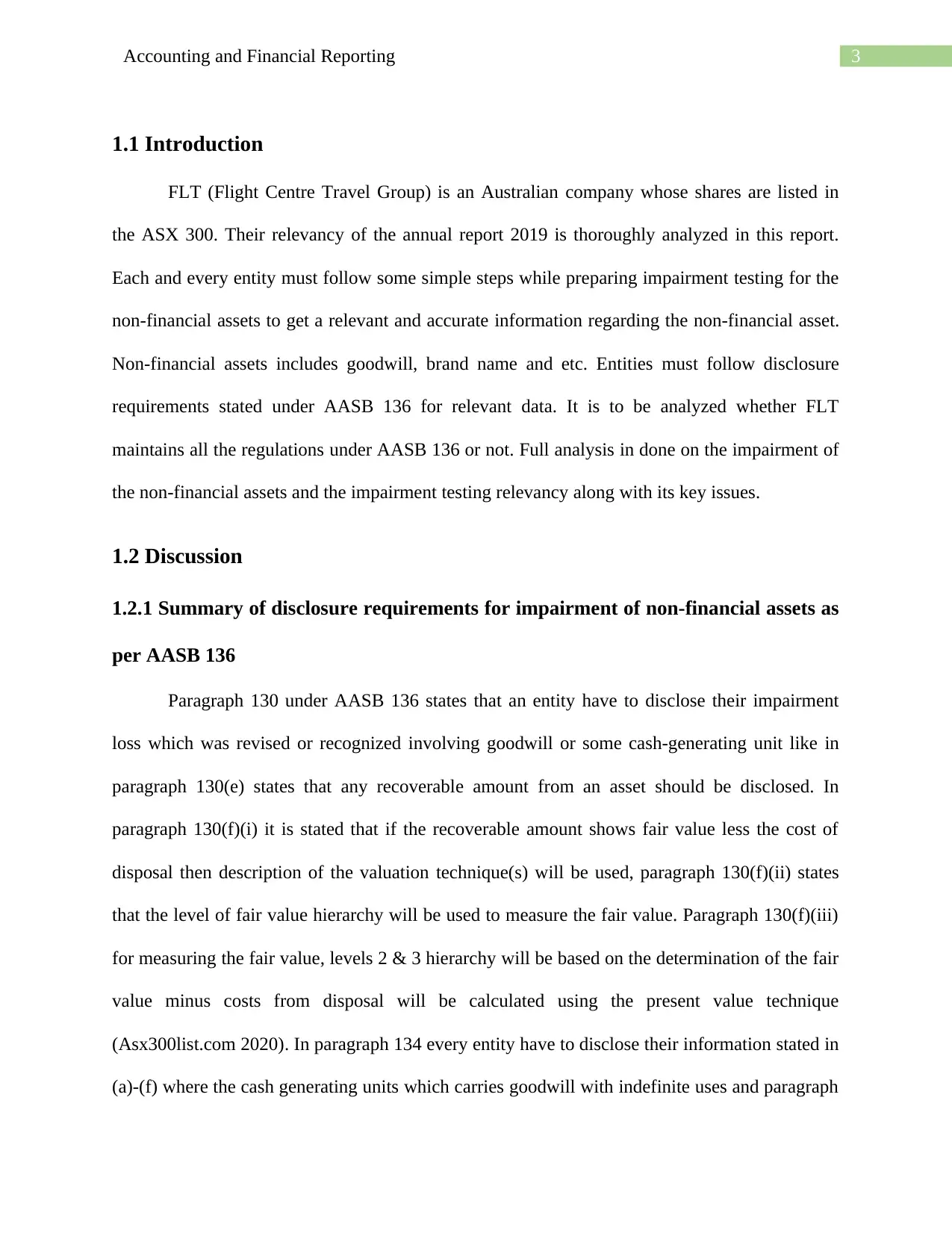
3Accounting and Financial Reporting
1.1 Introduction
FLT (Flight Centre Travel Group) is an Australian company whose shares are listed in
the ASX 300. Their relevancy of the annual report 2019 is thoroughly analyzed in this report.
Each and every entity must follow some simple steps while preparing impairment testing for the
non-financial assets to get a relevant and accurate information regarding the non-financial asset.
Non-financial assets includes goodwill, brand name and etc. Entities must follow disclosure
requirements stated under AASB 136 for relevant data. It is to be analyzed whether FLT
maintains all the regulations under AASB 136 or not. Full analysis in done on the impairment of
the non-financial assets and the impairment testing relevancy along with its key issues.
1.2 Discussion
1.2.1 Summary of disclosure requirements for impairment of non-financial assets as
per AASB 136
Paragraph 130 under AASB 136 states that an entity have to disclose their impairment
loss which was revised or recognized involving goodwill or some cash-generating unit like in
paragraph 130(e) states that any recoverable amount from an asset should be disclosed. In
paragraph 130(f)(i) it is stated that if the recoverable amount shows fair value less the cost of
disposal then description of the valuation technique(s) will be used, paragraph 130(f)(ii) states
that the level of fair value hierarchy will be used to measure the fair value. Paragraph 130(f)(iii)
for measuring the fair value, levels 2 & 3 hierarchy will be based on the determination of the fair
value minus costs from disposal will be calculated using the present value technique
(Asx300list.com 2020). In paragraph 134 every entity have to disclose their information stated in
(a)-(f) where the cash generating units which carries goodwill with indefinite uses and paragraph
1.1 Introduction
FLT (Flight Centre Travel Group) is an Australian company whose shares are listed in
the ASX 300. Their relevancy of the annual report 2019 is thoroughly analyzed in this report.
Each and every entity must follow some simple steps while preparing impairment testing for the
non-financial assets to get a relevant and accurate information regarding the non-financial asset.
Non-financial assets includes goodwill, brand name and etc. Entities must follow disclosure
requirements stated under AASB 136 for relevant data. It is to be analyzed whether FLT
maintains all the regulations under AASB 136 or not. Full analysis in done on the impairment of
the non-financial assets and the impairment testing relevancy along with its key issues.
1.2 Discussion
1.2.1 Summary of disclosure requirements for impairment of non-financial assets as
per AASB 136
Paragraph 130 under AASB 136 states that an entity have to disclose their impairment
loss which was revised or recognized involving goodwill or some cash-generating unit like in
paragraph 130(e) states that any recoverable amount from an asset should be disclosed. In
paragraph 130(f)(i) it is stated that if the recoverable amount shows fair value less the cost of
disposal then description of the valuation technique(s) will be used, paragraph 130(f)(ii) states
that the level of fair value hierarchy will be used to measure the fair value. Paragraph 130(f)(iii)
for measuring the fair value, levels 2 & 3 hierarchy will be based on the determination of the fair
value minus costs from disposal will be calculated using the present value technique
(Asx300list.com 2020). In paragraph 134 every entity have to disclose their information stated in
(a)-(f) where the cash generating units which carries goodwill with indefinite uses and paragraph
Paraphrase This Document
Need a fresh take? Get an instant paraphrase of this document with our AI Paraphraser
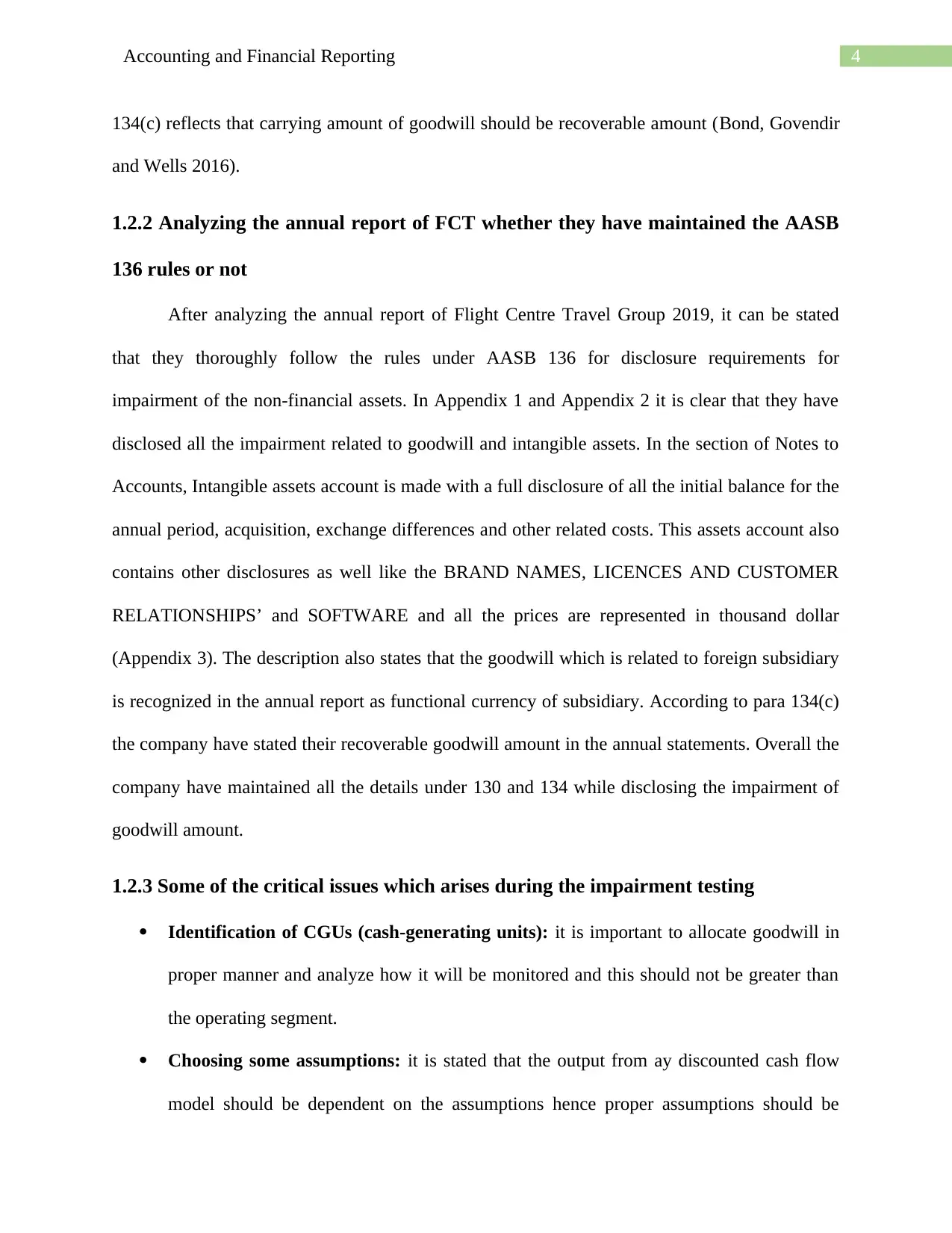
4Accounting and Financial Reporting
134(c) reflects that carrying amount of goodwill should be recoverable amount (Bond, Govendir
and Wells 2016).
1.2.2 Analyzing the annual report of FCT whether they have maintained the AASB
136 rules or not
After analyzing the annual report of Flight Centre Travel Group 2019, it can be stated
that they thoroughly follow the rules under AASB 136 for disclosure requirements for
impairment of the non-financial assets. In Appendix 1 and Appendix 2 it is clear that they have
disclosed all the impairment related to goodwill and intangible assets. In the section of Notes to
Accounts, Intangible assets account is made with a full disclosure of all the initial balance for the
annual period, acquisition, exchange differences and other related costs. This assets account also
contains other disclosures as well like the BRAND NAMES, LICENCES AND CUSTOMER
RELATIONSHIPS’ and SOFTWARE and all the prices are represented in thousand dollar
(Appendix 3). The description also states that the goodwill which is related to foreign subsidiary
is recognized in the annual report as functional currency of subsidiary. According to para 134(c)
the company have stated their recoverable goodwill amount in the annual statements. Overall the
company have maintained all the details under 130 and 134 while disclosing the impairment of
goodwill amount.
1.2.3 Some of the critical issues which arises during the impairment testing
Identification of CGUs (cash-generating units): it is important to allocate goodwill in
proper manner and analyze how it will be monitored and this should not be greater than
the operating segment.
Choosing some assumptions: it is stated that the output from ay discounted cash flow
model should be dependent on the assumptions hence proper assumptions should be
134(c) reflects that carrying amount of goodwill should be recoverable amount (Bond, Govendir
and Wells 2016).
1.2.2 Analyzing the annual report of FCT whether they have maintained the AASB
136 rules or not
After analyzing the annual report of Flight Centre Travel Group 2019, it can be stated
that they thoroughly follow the rules under AASB 136 for disclosure requirements for
impairment of the non-financial assets. In Appendix 1 and Appendix 2 it is clear that they have
disclosed all the impairment related to goodwill and intangible assets. In the section of Notes to
Accounts, Intangible assets account is made with a full disclosure of all the initial balance for the
annual period, acquisition, exchange differences and other related costs. This assets account also
contains other disclosures as well like the BRAND NAMES, LICENCES AND CUSTOMER
RELATIONSHIPS’ and SOFTWARE and all the prices are represented in thousand dollar
(Appendix 3). The description also states that the goodwill which is related to foreign subsidiary
is recognized in the annual report as functional currency of subsidiary. According to para 134(c)
the company have stated their recoverable goodwill amount in the annual statements. Overall the
company have maintained all the details under 130 and 134 while disclosing the impairment of
goodwill amount.
1.2.3 Some of the critical issues which arises during the impairment testing
Identification of CGUs (cash-generating units): it is important to allocate goodwill in
proper manner and analyze how it will be monitored and this should not be greater than
the operating segment.
Choosing some assumptions: it is stated that the output from ay discounted cash flow
model should be dependent on the assumptions hence proper assumptions should be
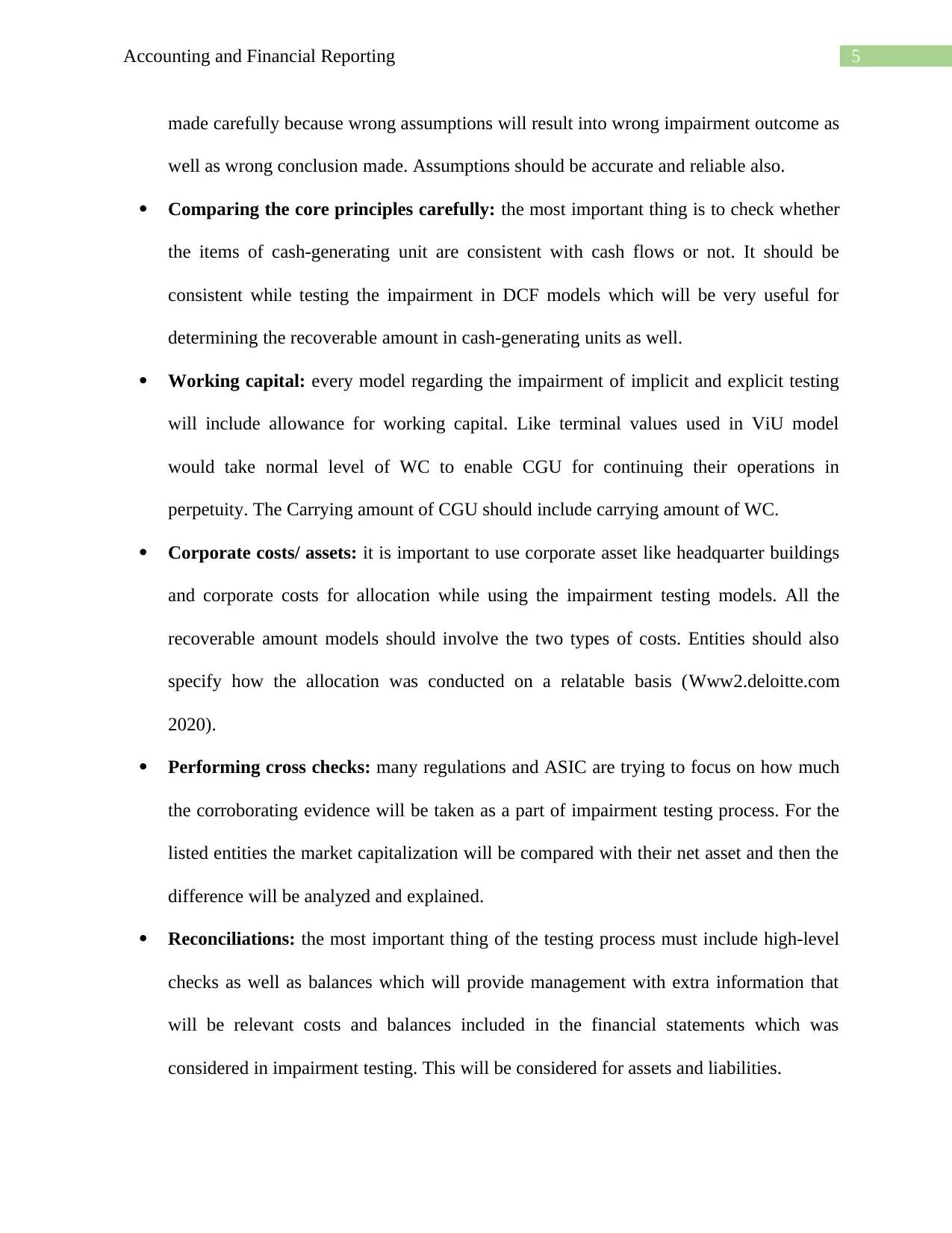
5Accounting and Financial Reporting
made carefully because wrong assumptions will result into wrong impairment outcome as
well as wrong conclusion made. Assumptions should be accurate and reliable also.
Comparing the core principles carefully: the most important thing is to check whether
the items of cash-generating unit are consistent with cash flows or not. It should be
consistent while testing the impairment in DCF models which will be very useful for
determining the recoverable amount in cash-generating units as well.
Working capital: every model regarding the impairment of implicit and explicit testing
will include allowance for working capital. Like terminal values used in ViU model
would take normal level of WC to enable CGU for continuing their operations in
perpetuity. The Carrying amount of CGU should include carrying amount of WC.
Corporate costs/ assets: it is important to use corporate asset like headquarter buildings
and corporate costs for allocation while using the impairment testing models. All the
recoverable amount models should involve the two types of costs. Entities should also
specify how the allocation was conducted on a relatable basis (Www2.deloitte.com
2020).
Performing cross checks: many regulations and ASIC are trying to focus on how much
the corroborating evidence will be taken as a part of impairment testing process. For the
listed entities the market capitalization will be compared with their net asset and then the
difference will be analyzed and explained.
Reconciliations: the most important thing of the testing process must include high-level
checks as well as balances which will provide management with extra information that
will be relevant costs and balances included in the financial statements which was
considered in impairment testing. This will be considered for assets and liabilities.
made carefully because wrong assumptions will result into wrong impairment outcome as
well as wrong conclusion made. Assumptions should be accurate and reliable also.
Comparing the core principles carefully: the most important thing is to check whether
the items of cash-generating unit are consistent with cash flows or not. It should be
consistent while testing the impairment in DCF models which will be very useful for
determining the recoverable amount in cash-generating units as well.
Working capital: every model regarding the impairment of implicit and explicit testing
will include allowance for working capital. Like terminal values used in ViU model
would take normal level of WC to enable CGU for continuing their operations in
perpetuity. The Carrying amount of CGU should include carrying amount of WC.
Corporate costs/ assets: it is important to use corporate asset like headquarter buildings
and corporate costs for allocation while using the impairment testing models. All the
recoverable amount models should involve the two types of costs. Entities should also
specify how the allocation was conducted on a relatable basis (Www2.deloitte.com
2020).
Performing cross checks: many regulations and ASIC are trying to focus on how much
the corroborating evidence will be taken as a part of impairment testing process. For the
listed entities the market capitalization will be compared with their net asset and then the
difference will be analyzed and explained.
Reconciliations: the most important thing of the testing process must include high-level
checks as well as balances which will provide management with extra information that
will be relevant costs and balances included in the financial statements which was
considered in impairment testing. This will be considered for assets and liabilities.
⊘ This is a preview!⊘
Do you want full access?
Subscribe today to unlock all pages.

Trusted by 1+ million students worldwide
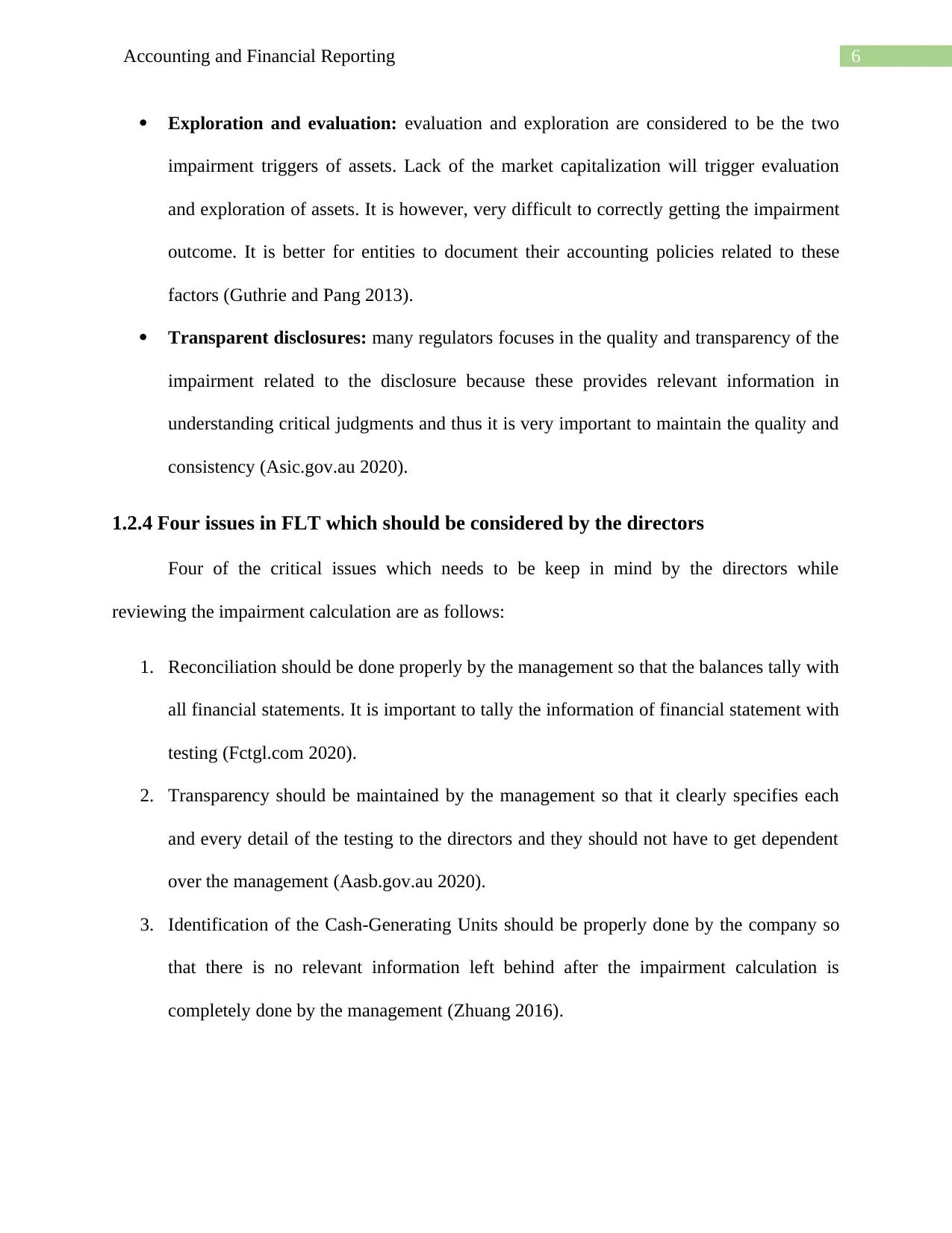
6Accounting and Financial Reporting
Exploration and evaluation: evaluation and exploration are considered to be the two
impairment triggers of assets. Lack of the market capitalization will trigger evaluation
and exploration of assets. It is however, very difficult to correctly getting the impairment
outcome. It is better for entities to document their accounting policies related to these
factors (Guthrie and Pang 2013).
Transparent disclosures: many regulators focuses in the quality and transparency of the
impairment related to the disclosure because these provides relevant information in
understanding critical judgments and thus it is very important to maintain the quality and
consistency (Asic.gov.au 2020).
1.2.4 Four issues in FLT which should be considered by the directors
Four of the critical issues which needs to be keep in mind by the directors while
reviewing the impairment calculation are as follows:
1. Reconciliation should be done properly by the management so that the balances tally with
all financial statements. It is important to tally the information of financial statement with
testing (Fctgl.com 2020).
2. Transparency should be maintained by the management so that it clearly specifies each
and every detail of the testing to the directors and they should not have to get dependent
over the management (Aasb.gov.au 2020).
3. Identification of the Cash-Generating Units should be properly done by the company so
that there is no relevant information left behind after the impairment calculation is
completely done by the management (Zhuang 2016).
Exploration and evaluation: evaluation and exploration are considered to be the two
impairment triggers of assets. Lack of the market capitalization will trigger evaluation
and exploration of assets. It is however, very difficult to correctly getting the impairment
outcome. It is better for entities to document their accounting policies related to these
factors (Guthrie and Pang 2013).
Transparent disclosures: many regulators focuses in the quality and transparency of the
impairment related to the disclosure because these provides relevant information in
understanding critical judgments and thus it is very important to maintain the quality and
consistency (Asic.gov.au 2020).
1.2.4 Four issues in FLT which should be considered by the directors
Four of the critical issues which needs to be keep in mind by the directors while
reviewing the impairment calculation are as follows:
1. Reconciliation should be done properly by the management so that the balances tally with
all financial statements. It is important to tally the information of financial statement with
testing (Fctgl.com 2020).
2. Transparency should be maintained by the management so that it clearly specifies each
and every detail of the testing to the directors and they should not have to get dependent
over the management (Aasb.gov.au 2020).
3. Identification of the Cash-Generating Units should be properly done by the company so
that there is no relevant information left behind after the impairment calculation is
completely done by the management (Zhuang 2016).
Paraphrase This Document
Need a fresh take? Get an instant paraphrase of this document with our AI Paraphraser
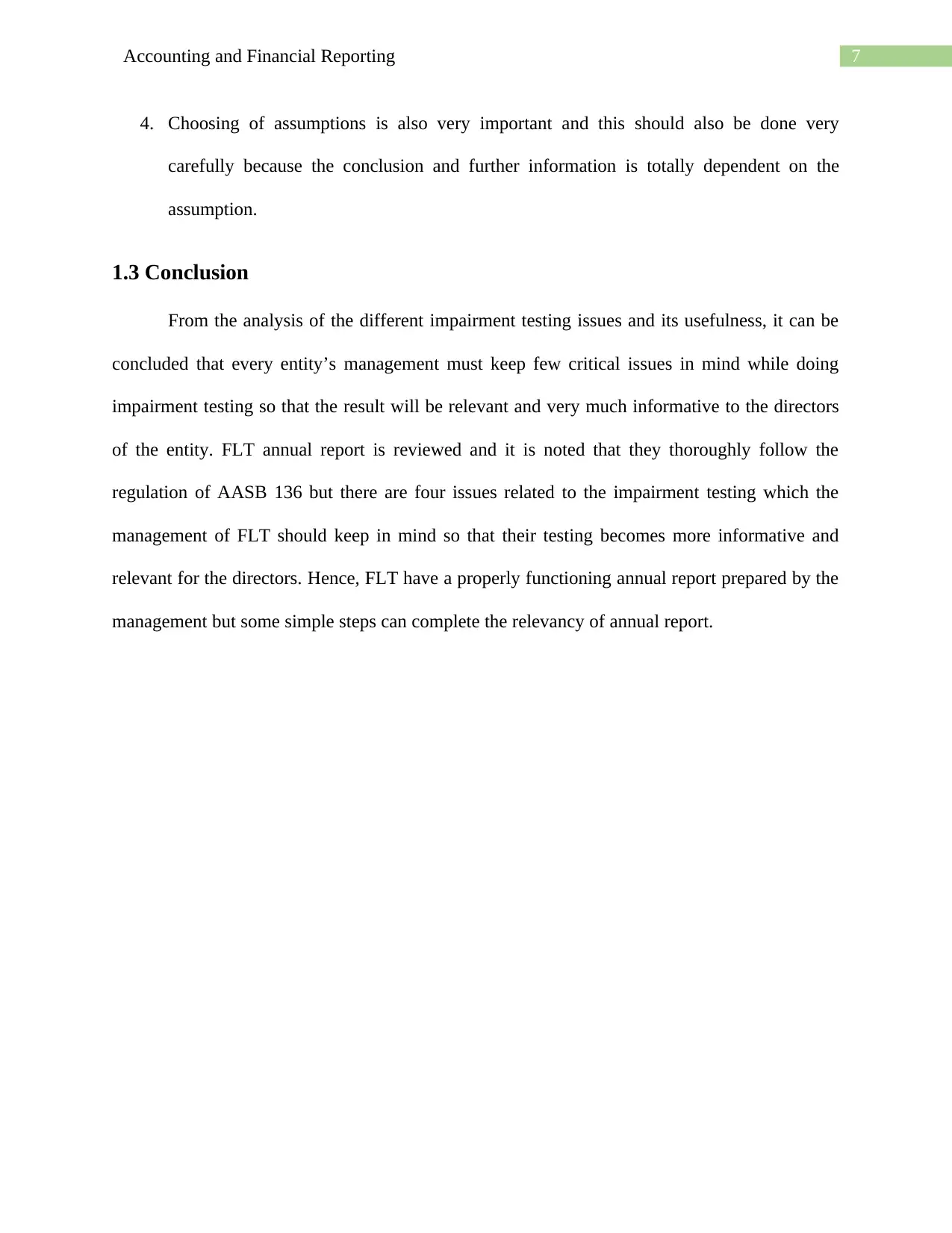
7Accounting and Financial Reporting
4. Choosing of assumptions is also very important and this should also be done very
carefully because the conclusion and further information is totally dependent on the
assumption.
1.3 Conclusion
From the analysis of the different impairment testing issues and its usefulness, it can be
concluded that every entity’s management must keep few critical issues in mind while doing
impairment testing so that the result will be relevant and very much informative to the directors
of the entity. FLT annual report is reviewed and it is noted that they thoroughly follow the
regulation of AASB 136 but there are four issues related to the impairment testing which the
management of FLT should keep in mind so that their testing becomes more informative and
relevant for the directors. Hence, FLT have a properly functioning annual report prepared by the
management but some simple steps can complete the relevancy of annual report.
4. Choosing of assumptions is also very important and this should also be done very
carefully because the conclusion and further information is totally dependent on the
assumption.
1.3 Conclusion
From the analysis of the different impairment testing issues and its usefulness, it can be
concluded that every entity’s management must keep few critical issues in mind while doing
impairment testing so that the result will be relevant and very much informative to the directors
of the entity. FLT annual report is reviewed and it is noted that they thoroughly follow the
regulation of AASB 136 but there are four issues related to the impairment testing which the
management of FLT should keep in mind so that their testing becomes more informative and
relevant for the directors. Hence, FLT have a properly functioning annual report prepared by the
management but some simple steps can complete the relevancy of annual report.
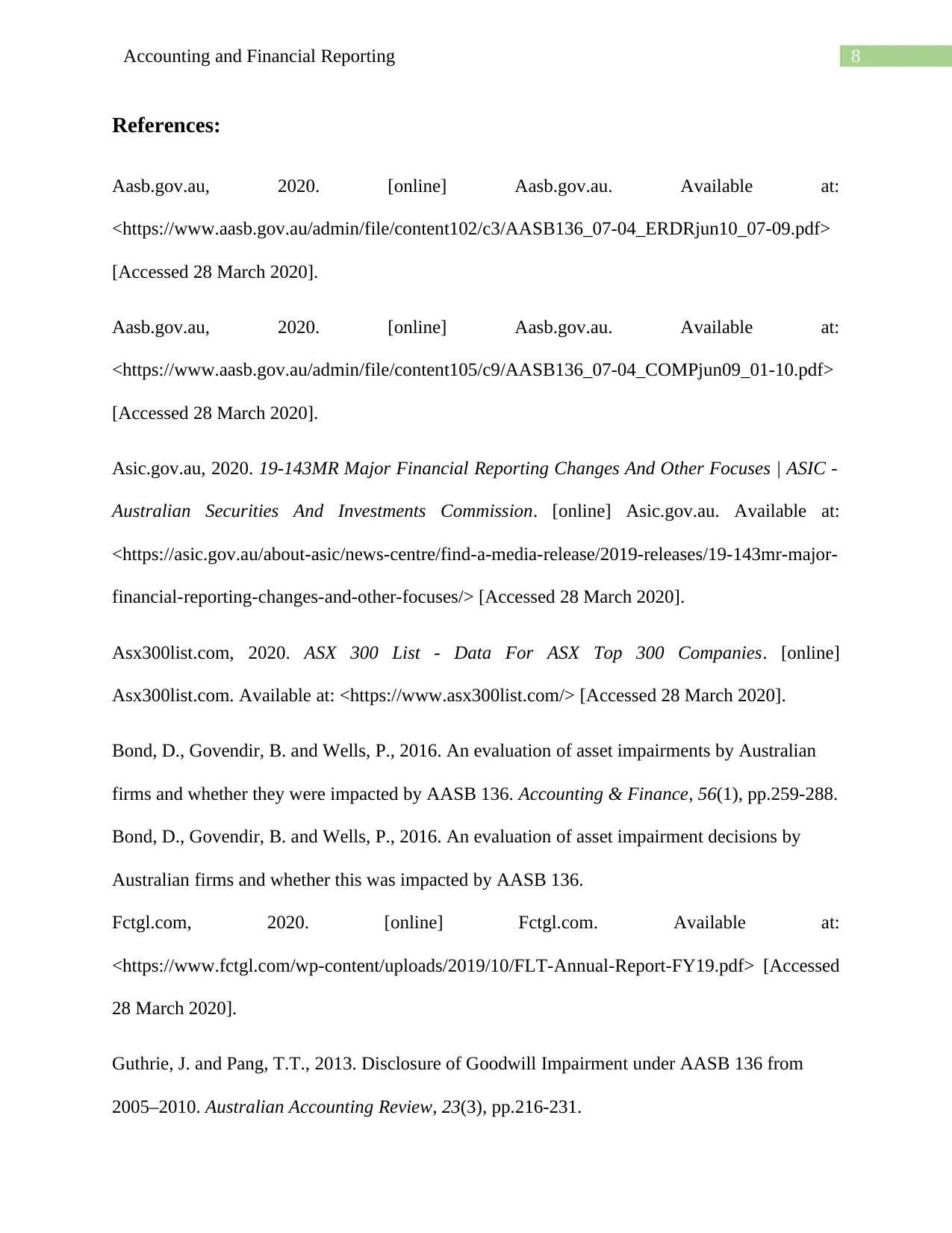
8Accounting and Financial Reporting
References:
Aasb.gov.au, 2020. [online] Aasb.gov.au. Available at:
<https://www.aasb.gov.au/admin/file/content102/c3/AASB136_07-04_ERDRjun10_07-09.pdf>
[Accessed 28 March 2020].
Aasb.gov.au, 2020. [online] Aasb.gov.au. Available at:
<https://www.aasb.gov.au/admin/file/content105/c9/AASB136_07-04_COMPjun09_01-10.pdf>
[Accessed 28 March 2020].
Asic.gov.au, 2020. 19-143MR Major Financial Reporting Changes And Other Focuses | ASIC -
Australian Securities And Investments Commission. [online] Asic.gov.au. Available at:
<https://asic.gov.au/about-asic/news-centre/find-a-media-release/2019-releases/19-143mr-major-
financial-reporting-changes-and-other-focuses/> [Accessed 28 March 2020].
Asx300list.com, 2020. ASX 300 List - Data For ASX Top 300 Companies. [online]
Asx300list.com. Available at: <https://www.asx300list.com/> [Accessed 28 March 2020].
Bond, D., Govendir, B. and Wells, P., 2016. An evaluation of asset impairments by Australian
firms and whether they were impacted by AASB 136. Accounting & Finance, 56(1), pp.259-288.
Bond, D., Govendir, B. and Wells, P., 2016. An evaluation of asset impairment decisions by
Australian firms and whether this was impacted by AASB 136.
Fctgl.com, 2020. [online] Fctgl.com. Available at:
<https://www.fctgl.com/wp-content/uploads/2019/10/FLT-Annual-Report-FY19.pdf> [Accessed
28 March 2020].
Guthrie, J. and Pang, T.T., 2013. Disclosure of Goodwill Impairment under AASB 136 from
2005–2010. Australian Accounting Review, 23(3), pp.216-231.
References:
Aasb.gov.au, 2020. [online] Aasb.gov.au. Available at:
<https://www.aasb.gov.au/admin/file/content102/c3/AASB136_07-04_ERDRjun10_07-09.pdf>
[Accessed 28 March 2020].
Aasb.gov.au, 2020. [online] Aasb.gov.au. Available at:
<https://www.aasb.gov.au/admin/file/content105/c9/AASB136_07-04_COMPjun09_01-10.pdf>
[Accessed 28 March 2020].
Asic.gov.au, 2020. 19-143MR Major Financial Reporting Changes And Other Focuses | ASIC -
Australian Securities And Investments Commission. [online] Asic.gov.au. Available at:
<https://asic.gov.au/about-asic/news-centre/find-a-media-release/2019-releases/19-143mr-major-
financial-reporting-changes-and-other-focuses/> [Accessed 28 March 2020].
Asx300list.com, 2020. ASX 300 List - Data For ASX Top 300 Companies. [online]
Asx300list.com. Available at: <https://www.asx300list.com/> [Accessed 28 March 2020].
Bond, D., Govendir, B. and Wells, P., 2016. An evaluation of asset impairments by Australian
firms and whether they were impacted by AASB 136. Accounting & Finance, 56(1), pp.259-288.
Bond, D., Govendir, B. and Wells, P., 2016. An evaluation of asset impairment decisions by
Australian firms and whether this was impacted by AASB 136.
Fctgl.com, 2020. [online] Fctgl.com. Available at:
<https://www.fctgl.com/wp-content/uploads/2019/10/FLT-Annual-Report-FY19.pdf> [Accessed
28 March 2020].
Guthrie, J. and Pang, T.T., 2013. Disclosure of Goodwill Impairment under AASB 136 from
2005–2010. Australian Accounting Review, 23(3), pp.216-231.
⊘ This is a preview!⊘
Do you want full access?
Subscribe today to unlock all pages.

Trusted by 1+ million students worldwide
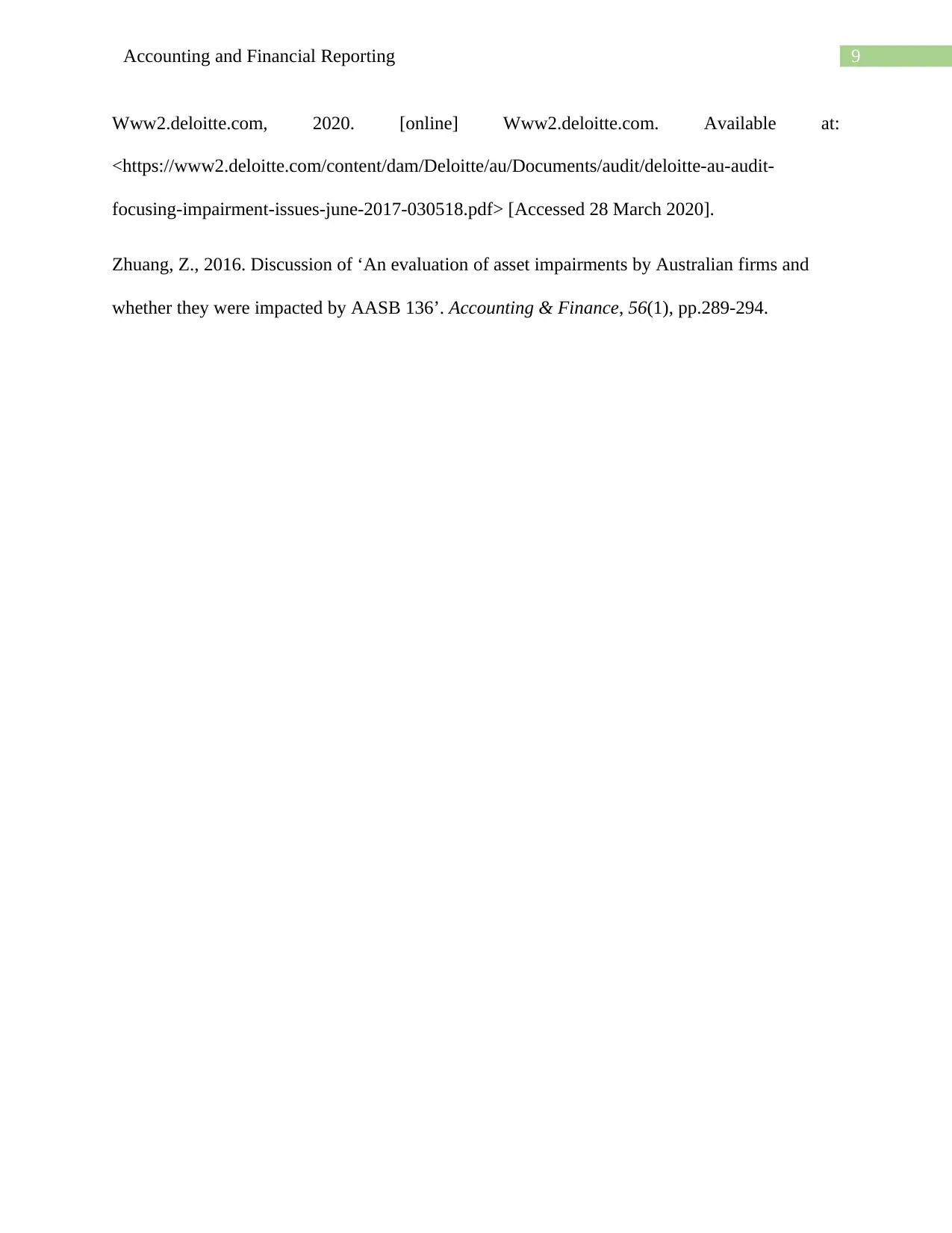
9Accounting and Financial Reporting
Www2.deloitte.com, 2020. [online] Www2.deloitte.com. Available at:
<https://www2.deloitte.com/content/dam/Deloitte/au/Documents/audit/deloitte-au-audit-
focusing-impairment-issues-june-2017-030518.pdf> [Accessed 28 March 2020].
Zhuang, Z., 2016. Discussion of ‘An evaluation of asset impairments by Australian firms and
whether they were impacted by AASB 136’. Accounting & Finance, 56(1), pp.289-294.
Www2.deloitte.com, 2020. [online] Www2.deloitte.com. Available at:
<https://www2.deloitte.com/content/dam/Deloitte/au/Documents/audit/deloitte-au-audit-
focusing-impairment-issues-june-2017-030518.pdf> [Accessed 28 March 2020].
Zhuang, Z., 2016. Discussion of ‘An evaluation of asset impairments by Australian firms and
whether they were impacted by AASB 136’. Accounting & Finance, 56(1), pp.289-294.
Paraphrase This Document
Need a fresh take? Get an instant paraphrase of this document with our AI Paraphraser
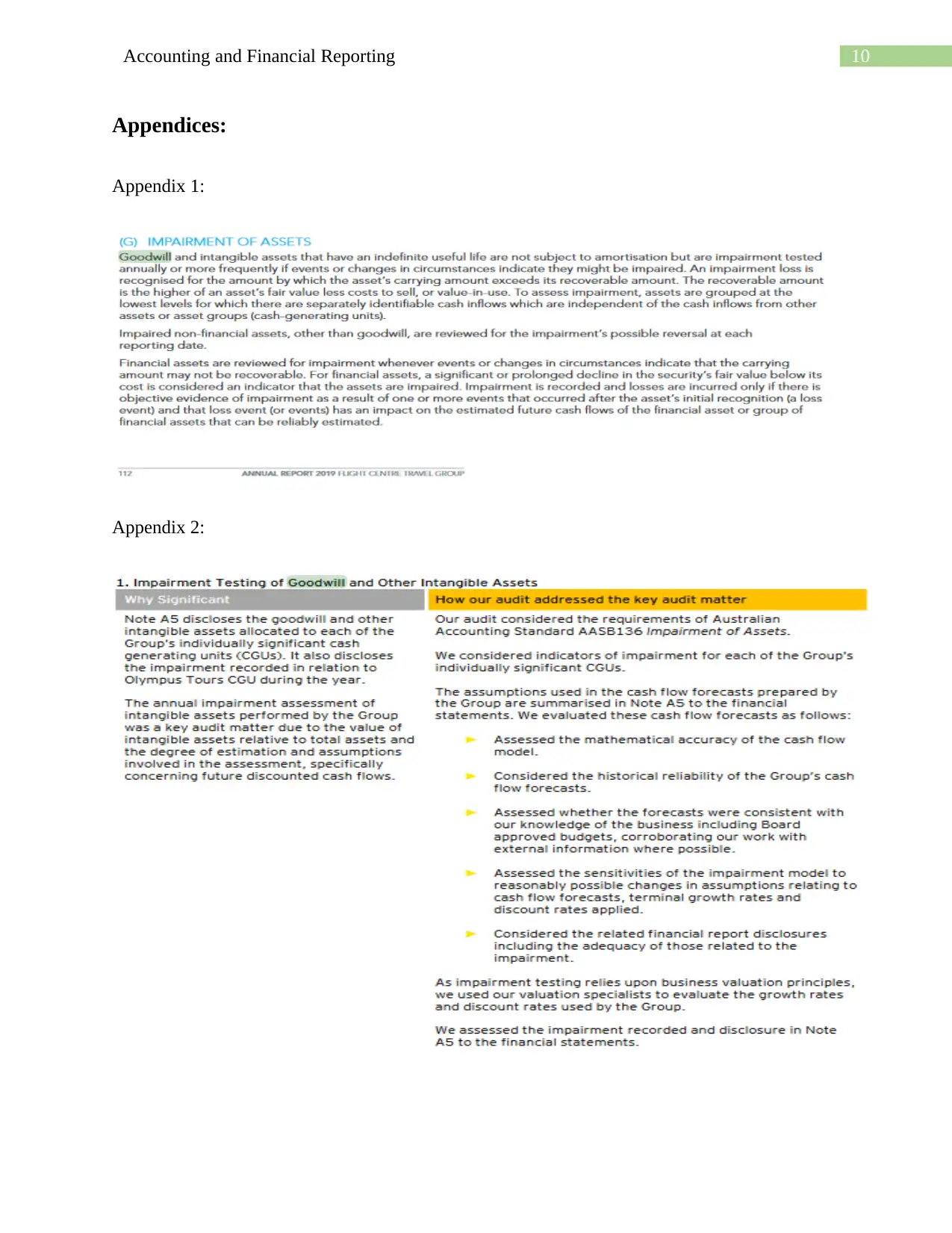
10Accounting and Financial Reporting
Appendices:
Appendix 1:
Appendix 2:
Appendices:
Appendix 1:
Appendix 2:
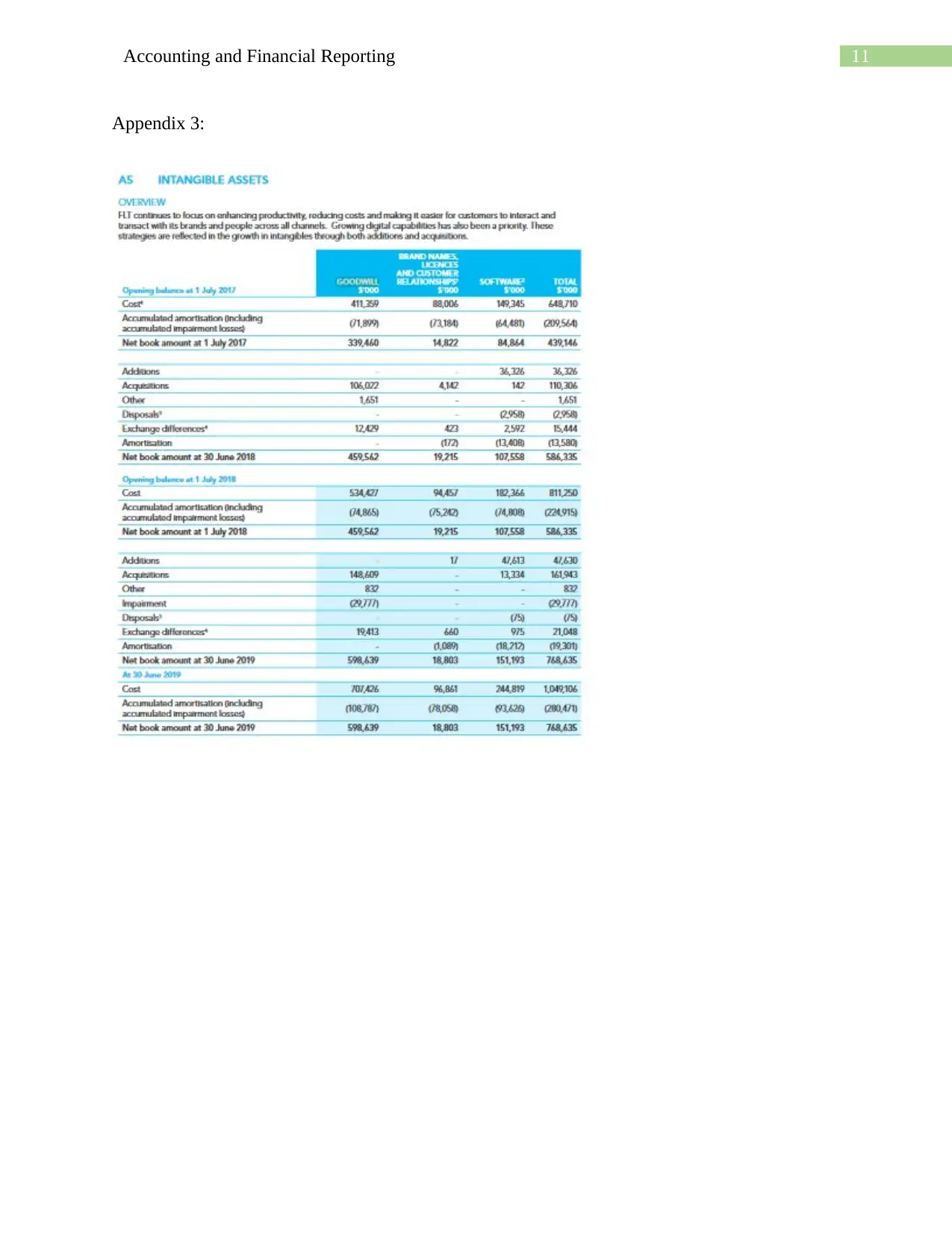
11Accounting and Financial Reporting
Appendix 3:
Appendix 3:
⊘ This is a preview!⊘
Do you want full access?
Subscribe today to unlock all pages.

Trusted by 1+ million students worldwide
1 out of 12
Related Documents
Your All-in-One AI-Powered Toolkit for Academic Success.
+13062052269
info@desklib.com
Available 24*7 on WhatsApp / Email
![[object Object]](/_next/static/media/star-bottom.7253800d.svg)
Unlock your academic potential
Copyright © 2020–2025 A2Z Services. All Rights Reserved. Developed and managed by ZUCOL.




